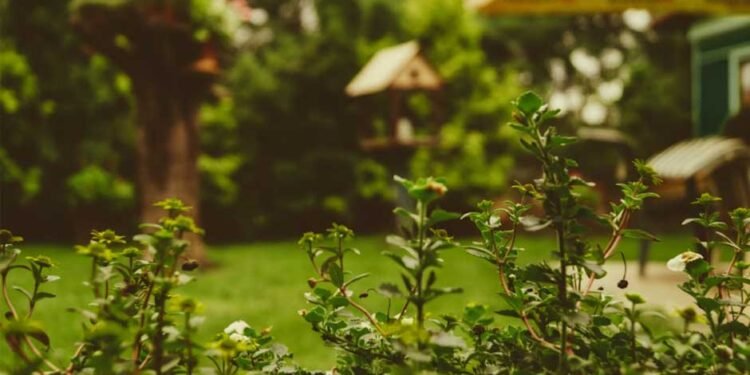Many homeowners dream of having a vast and plentiful garden in their yard. It’s a chance to have flowers that will beautify the property and to grow vegetables you can enjoy directly from the plant.
If you want to help the planet and contribute to biodiversity, you need to choose each element of your outdoor space carefully and make the right decisions about maintenance. Here is your guide to practicing sustainability in your healthy garden.
Choosing Eco-Friendly Components
The journey to a truly eco-friendly garden starts from the very beginning when you’re laying the foundation of your planting space.
One simple way to make your home more sustainable is to avoid using plastic whenever possible. When you’re growing a garden and you start to pay attention, you’ll notice that everything from the weed barriers and plant markers to your gardening tools contains plastic. With a bit of research and shopping around, you can find items that are just as helpful but are made of bamboo, straw, and other organic materials.
In addition to avoiding the use of plastic in your garden, you can reduce plastics in your home as well. Use reusable water bottles instead of buying disposable bottles from the store. Also, if you use a straw, go for glass or bamboo instead of plastic.
Composting to create a sustainable bottom layer is a great way to help your garden and the planet. Good composting combines natural elements like flower trimmings and grass clippings with food waste, like coffee grounds, fruit and vegetable peels, egg shells, and other kitchen scraps, to enrich the soil and provide better nutrients.
While it may seem expensive to start a sustainable garden from the ground up, it’s not impossible to affordably invest in eco-friendly home upgrades. The government offers many tax incentives for green initiatives. Credit cards are the most straightforward option, provided you have the credit. Meanwhile, if you plan on a more elaborate garden, you may even be able to leverage home equity.
Water Conservation Tips
When you’re working to help your garden grow and thrive, try to do so without wasting a lot of water. Water is a valued natural resource. This doesn’t mean that your plants don’t need it (or that your patio or yard doesn’t need the occasional wash); you just need to be strategic about how you use it.
One of the most straightforward water conservation strategies is to pick the best times to nourish the garden. Instead of watering in the middle of the day, when the heat causes quicker evaporation, choose to water at night or earlier in the morning.
You should also use the weather to your advantage. Check the forecast, and if it’s going to rain, don’t water that day. Also, you can avoid watering if it has rained in the past 24 hours. Another way to take advantage of rainfall is to make several rain barrels. Place them along your house to collect the rainwater from your roof. Then, use that to water your garden.
When it comes to preserving water, another environmentally friendly gardening tip is to add plants that don’t need as much moisture to survive. Even if you get rain periodically, choose drought-tolerant flowers and plants that can survive year after year, including peonies, lavender, and chrysanthemums. These gorgeous species will survive with a fraction of the water, so you’ll be doing a great service to the world.
Support Biodiversity
You can also help to support your local ecosystem by increasing the biodiversity in your garden. This is the best way to ensure a healthy environment for all natural organisms.
One of the primary steps in creating a biodiverse garden is to add native plants. Plants common to the area are more likely to thrive because they’ve adapted to the climate and the soil. Native plants are also friends of the wildlife in the area. Most importantly, they’re likely to attract pollinating insects that will help the other plants in your garden and the surrounding forest thrive.
It’s also nice to attract birds to your garden to contribute to biodiversity. Doing so may require you to move out of the garden and into the surrounding yard by planting shrubs and trees that provide shelter and food. In addition to planting trees, you can help the birds by putting out birdhouses and baths.
Finally, be aware of invasive plant species that can harm the existing ecosystem and the native plants. As soon as you see them creeping in, remove them. Instead of using pesticides, dig the plants out by the root. Also, ensure you’re not being sold an invasive species at the store.
Mental Health Benefits
Creating an eco-friendly garden in your backyard not only helps preserve biodiversity but also offers significant mental health benefits. Spending time outdoors surrounded by nature can reduce stress, improve mood, and enhance cognitive function. Gardens filled with native plants, wildlife-friendly spaces, and sustainable practices can provide a sanctuary that fosters relaxation and mindfulness.
Climate change greatly affects mental health, and will likely continue to do so, resulting in rising feelings of anxiety, depression, and feelings of helplessness. Support resources, including social workers and mental health professionals, can be a huge help in this area. Smaller steps, however, like creating an eco-friendly garden and even just spending time outside, can further bolster these efforts.
By cultivating a space that promotes mental well-being and supports nature, you contribute to both your emotional resilience and the planet’s health. Here are some of the main benefits of spending time outside:
- Reduces stress: Time spent in nature has been shown to lower cortisol levels, helping to manage stress.
- Boosts mood: Gardening and outdoor activities can elevate serotonin levels, improving overall mood and well-being.
- Increases mindfulness: Being in nature encourages mindfulness, which helps combat anxiety and depression.
- Supports cognitive function: Spending time outdoors can improve focus and mental clarity, leading to better mental health.
- Combats climate change anxiety: Creating a sustainable outdoor space empowers individuals to take action, reducing feelings of helplessness related to environmental issues.
It’s awesome that you’re making a garden that you can enjoy and also benefits the planet. The people and animals of the world thank you. Follow these steps and keep on top of maintenance, and you’ll have a space your family and the local ecosystem can enjoy year after year.












